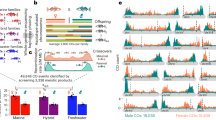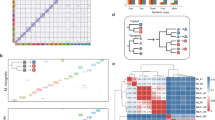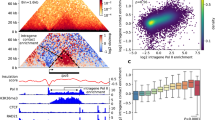Abstract
Using a computer simulation, we have examined the dynamics of recombinational speciation, a potentially rapid mode of evolution dependent on chromosomal reassortment in populations of partially sterile interspecific hybrids. We describe how various parameters affect the time required for a new recombinant species to become established within the setting of a spatially structured hybrid zone. Our results indicate that recombinational speciation is most likely to occur where (1) the hybrid zone interface is long, (2) the organisms involved are predominantly selfing, (3) the hybrids are relatively fertile, and (4) the number of differences in chromosomal structure between the parental species is small. The speciation dynamics are characterized by long-term stasis followed by an abrupt transition to a new reproductively isolated type. The results are largely the same whether the nascent recombinant species is favoured by a fertility or a viability advantage. Recombinational speciation, like polyploidy, appears to be a feasible mechanism for sympatric speciation in plants.
Similar content being viewed by others
Article PDF
References
Gallez, G P, and Gottlieb, L D. 1982. Genetic evidence for the hybrid origin of the diploid plant Stephanomeria diegensis. Evolution, 36, 1158–1167.
Grant, V. 1958. The regulation of recombination in plants. In: Exchange of Genetic Material: Mechanisms and Consequences, pp. 337–363. Cold Spring Harb. Symp. Quant. Biol., vol. 23. Cold Spring Harbor, New York.
Grant, V. 1963. The Origin of Adaptations. Columbia University Press, New York.
Grant, V. 1966a. Selection for vigor and fertility in the progeny of a highly sterile species hybrid in Gilia. Genetics, 53, 757–775.
Grant, V. 1966b. The origin of a new species of Gilia in a hybridization experiment. Genetics, 54, 1189–1199.
Grant, V. 1971. Plant Speciation. Columbia University Press, New York.
Grant, V. 1985. The Evolutionary Process. Columbia University Press, New York.
Rieseberg, L H. 1991. Homoploid reticulate evolution in Helianthus (Asteraceae): evidence from ribosomal genes. Am J Bot, 78, 1218–1237.
Rieseberg, L H, Carter, R, and Zona, S. 1990. Molecular tests of the hypothesized origin of two diploid species (Asteraceae). Evolution, 44, 1498–1511.
Rouhani, S, and Barton, N. 1987. Speciation and the 'shifting balance' in a continuous population. Theor Pop Biol, 31, 465–492.
Stebbins, G L. 1957. The hybrid origin of microspecies in the Elymus glaucus complex. Cytologia, Suppl. Vol., 336–340.
Stebbins, G L. 1958. The inviability, weakness, and sterility of interspecific hybrids. Adv Genet, 9, 147–215.
Author information
Authors and Affiliations
Rights and permissions
About this article
Cite this article
McCarthy, E., Asmussen, M. & Anderson, W. A theoretical assessment of recombinational speciation. Heredity 74, 502–509 (1995). https://doi.org/10.1038/hdy.1995.71
Received:
Issue date:
DOI: https://doi.org/10.1038/hdy.1995.71
Keywords
This article is cited by
-
Confirmation of an interspecific hybrid of Drimia based on mitotic, stomatal and ISSR marker analyses
The Nucleus (2021)
-
Introgressive hybridization as a mechanism for species rescue
Theoretical Ecology (2011)
-
Morphological and molecular (RAPD) analyses confirm the hybrid origin of the diploid grassCalamagrostis longiseta var.longe-aristata (Gramineae)
Folia Geobotanica (2007)
-
Speciation by hybridization in Heliconius butterflies
Nature (2006)
-
Reproductive isolation of a new hybrid species, Senecio eboracensis Abbott & Lowe (Asteraceae)
Heredity (2004)



